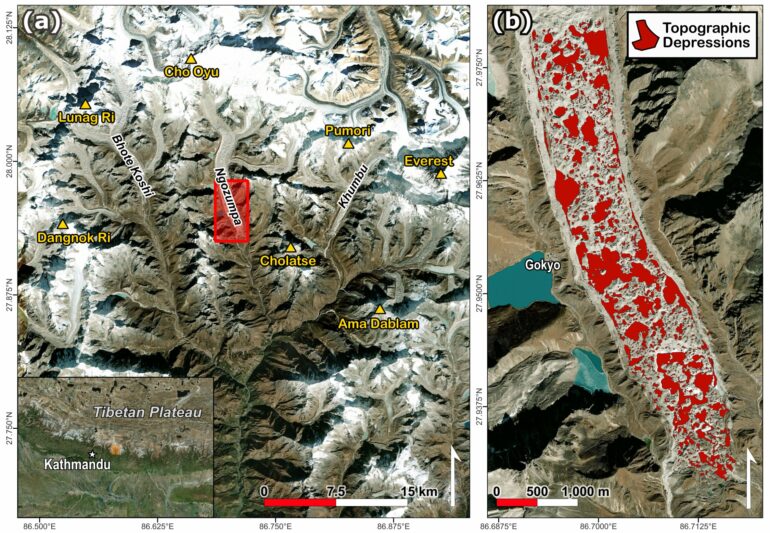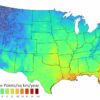by Ryan M. Strickland
One in five glaciers on Earth are covered with a layer of rocky debris. The presence of debris influences how glaciers melt. In the Himalaya, debris covers most large glaciers, and it is so thick that it should insulate the ice, slowing the rates of melt. However, many debris-covered glaciers melt just as fast as glaciers with no debris. This anomaly is known as the debris cover paradox.
Understanding the causes of the debris cover paradox is necessary to predict melt rates and water availability in southern Asia in response to climate change. The paradox is partly explained by the development of ice cliffs and meltwater ponds on the glacier surfaces. Although ponds and ice cliffs occupy only a tiny fraction of the glacier surface, they account for nearly half of glacier melt.
Pond and ice cliff growth occurs simultaneously with the development of hummocky topography on the glacier surface. The hummocky topography is complex. Contrasts in melt rate cause thousands of hills, known as hummocks, to form across the surface of the glaciers. Understanding how the hummocky topography evolves will help scientists more accurately predict the growth of ponds and ice cliffs, and therefore better predict melt rates.
The enigma of hummocky topography
Most attribute the development of hummocky topography to variable debris thickness. When the debris is thinner than a few centimeters, melt rates increase compared to bare ice, but thick debris insulates the ice and decreases melt rates. According to this hypothesis, the hummocks develop because debris is thicker on the hilltops. However, the ruggedness of the terrain and difficulty of conducting research in the thin Himalayan air have made it challenging to test this hypothesis.
During 2018 and 2019 expeditions to the Everest Region in Nepal, Dr. Matt Covington, Dr. Jason Gulley and I used a drone to photograph the Ngozumpa Glacier. We used these data to investigate patterns in the topography to better understand how it evolves. Our research has now been published in the journal Geophysical Research Letters.
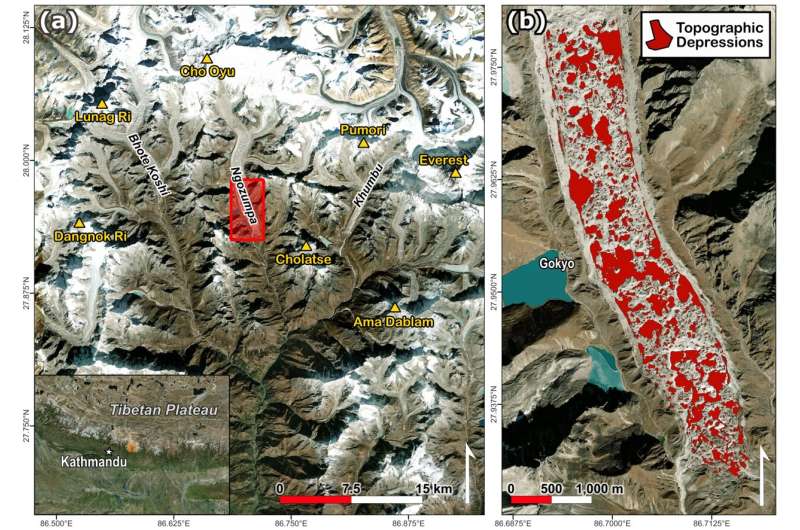
(a) The Ngozumpa Glacier is the largest glacier in the Everest Region of Nepal. (b) There were 3,073 depressions larger than 10 m2 in the study area. © Geophysical Research Letters (2023). DOI: 10.1029/2023GL104389
Our observations revealed something interesting. In addition to the hummocks, thousands of enclosed topographic depressions pit the hummocky surface. Few landscapes on Earth develop an abundance of depressions. Although meltwater ponds formed in some of the depressions, it appeared that most of them were completely dry. How did these depressions form, and why don’t all of the depressions have ponds?
To answer these questions, we stitched together thousands of drone images to produce one of the highest resolution maps of the Ngozumpa Glacier ever created. Using this map, we examined the sizes and geometry of the depressions to better understand how they form and grow.
Positive feedback depression growth
After analyzing our data, we found that the depression areas followed a power-law distribution. In other words, there are far more extremely large depressions than should arise through random chance. The depressions also followed power-law geometric scaling relationships, which show the depressions obey fractal geometry. Only a handful of physical processes are known to generate power-law distributions and fractal geometry. The most plausible mechanism for the depressions was positive feedback growth.
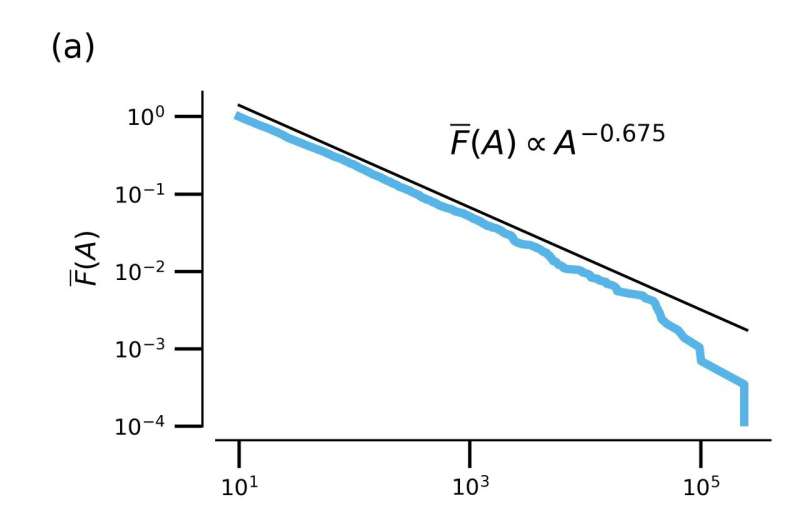
(a) The distribution of depression areas is power-law. (b) The depression perimeter-area scaling, more commonly known as the fractal dimension, indicates a fractal dimension D = 1.16. (c) Depression depths increased as depression areas increased. In (b) and (c), the black dots represent depressions with ponds. Less than 5% of the depressions had ponds during our survey. © Geophysical Research Letters (2023). DOI: 10.1029/2023GL104389
The possibility of positive feedback depression growth contradicted what should arise from melt beneath debris. If variable thickness debris produced the depressions, then the downhill movement of debris should gradually fill the depressions and limit their growth. That is, downhill debris movement creates a negative feedback to depression growth. The power-law scaling relationships we measured suggest no negative feedbacks. The power-law distribution was evidence that variable thickness debris does not explain the development of depressions or hummocky topography.
Before we could make this claim, we needed to find out if only positive feedback growth could produce similar size distributions. To do this, we developed a relatively simple geometric model. In the model, depressions begin as small circles that expand according to a growth rate rule. We tested a range of possible growth rates, as well as the influence of mergers between adjacent depressions. The results showed that only strong positive feedback growth could produce power-law size distributions similar to the depressions on the Ngozumpa Glacier.
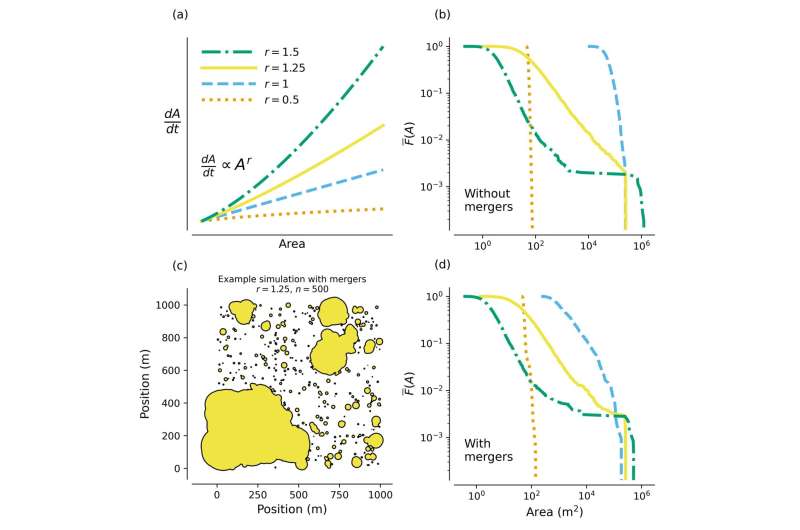
(a) Depression growth rates as a function of depression area. Example distributions for n=500 (b) without mergers and (d) with mergers. The growth rate exponents used for the distributions shown in (b) and (d) correspond to colors and line styles used in (a). (c) An example model showing a simulation with mergers. Only strong positive feedback growth (r≥1) produced power-law distributions of depression areas. © Geophysical Research Letters (2023). DOI: 10.1029/2023GL104389
Depressions grow like sinkholes
Karst landscapes are one of the few terrains on Earth that develop an abundance of topographic depressions, more commonly known as sinkholes. In karst, sinkholes develop in places where water and sediment drain into cracks in the bedrock. Interestingly, the power-law scaling relationships of depressions on the Ngozumpa Glacier were strikingly similar to sinkholes that develop in karst. Furthermore, debris-covered glaciers are known to develop caves, just like karst.
Upon a closer examination of our data, we found that out of more than 3,000 depressions on the Ngozumpa Glacier, fewer than 5% had ponds. Drainage into crevasses hidden beneath the debris could explain the dry depressions by routing meltwater into caves within the glacier.
Englacial drainage helps explain positive feedback depression growth. If depressions did not drain englacially, ponds would eventually overflow the depression. This overflow would limit depression growth by cutting away the depression border. Englacial drainage can also remove debris from the depression bottom. This slows the accumulation of debris, which is a negative feedback to depression growth.
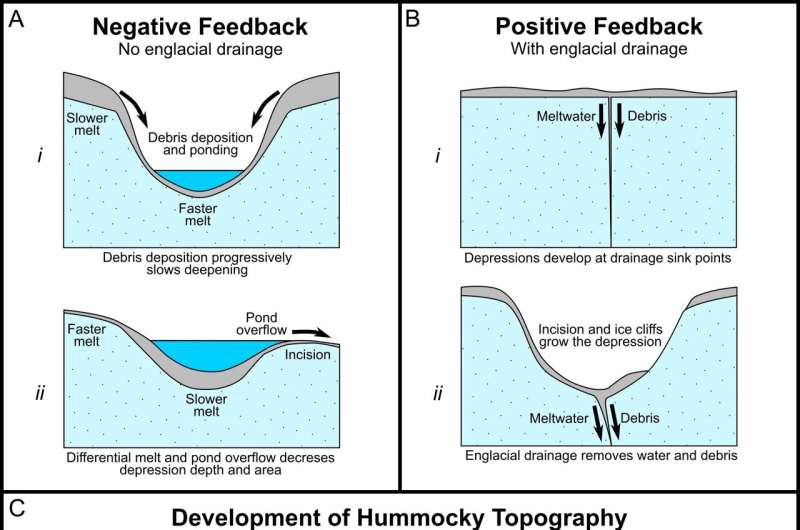
(A) The variable debris thickness mechanism for depression development causes negative feedback from debris accumulation and pond overflow. This is because debris deposition thickens slows melt within the depression. Without englacial drainage, ponds will fill and overflow the depression, decreasing its area. (B) Englacial drainage enables positive feedback growth by allowing debris removal and meltwater drainage from the depression bottom. (C) Hummocky topography develops via the growth of topographic depressions. Crevasses and permeable seams of englacial debris that connect areas of lower hydraulic potential act as sink points for meltwater and debris. © Geophysical Research Letters (2023). DOI: 10.1029/2023GL104389
Englacial insights
The most important conclusion from our analyses is that variable thickness debris cannot explain positive feedback depression growth. This means that debris thickness does not completely explain the development of hummocky topography. Other processes must be driving the formation of melt-enhancing ponds and ice cliffs.
Our analyses provided evidence that depressions develop similarly to sinkholes. Englacial drainage helps explain positive feedback depression growth and the presence of thousands of dry depressions. Therefore, predicting melt rates on debris-covered glaciers and solving the debris cover paradox may depend on understanding how englacial drainage networks evolve.
This story is part of Science X Dialog, where researchers can report findings from their published research articles. Visit this page for information about ScienceX Dialog and how to participate.
More information:
R. M. Strickland et al, Englacial Drainage Drives Positive Feedback Depression Growth on the Debris‐Covered Ngozumpa Glacier, Nepal, Geophysical Research Letters (2023). DOI: 10.1029/2023GL104389
Ryan Strickland is a PhD student at the University of Arkansas in Fayetteville. His current research combines numerical modeling with expedition field work in the Himalaya and Alaska to better understand the evolution of debris-covered glaciers.
Citation:
Unraveling a paradox of Himalayan glacier melt (2023, September 6)
